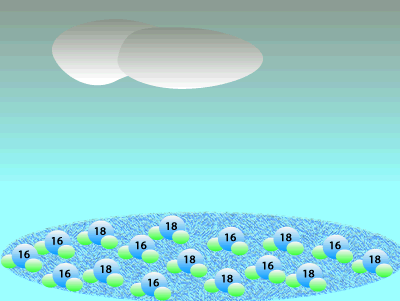Oxygen 16O and paleoclimatology
Solutions
Oxygen consists of three isotopes: 16O, 17O, and 18O. A large percentage ((99.762%) of the Earth's oxygen is 16O and the rest we can say is 18O. A tiny, negligible, amount is 17O but we will ignore this for simplicity. Although the percentage of 18O is small we can still measure the ratio of 18O to 16O. This means that any mineral containing oxygen, or ice, will have a measurable ratio of 18O to 16O atoms. This ratio of the 18O to 16O is temperature dependent so we can determine the temperature at the time by simply measuring the ratio of these two isotopes.

When water vapour condenses to form rain it is the heavier, less mobile water molecules that form rain.
This leaves a greater percentage of the lighter water molecule in the air as water vapour.


1) What is an isotope?
Isotopes are atoms of the same element that differ in the number of neutrons found in their nucleus.
2) What do isotopes have in common?
Isotopes of the same element all have the same number of protons in their nuclei.
3) Two water molecules are at the same temperature, they have the same average kinetic energy. One has an 16O isotope while the other has an 18O isotope. Which one travels with greater speed? Explain.
The formula for kinetic energy is 1/2mv2
If two molecules have the same kinetic energy but one is lighter it must have a greater speed (v) to make up for the lower mass.
4) In order to evaporate water molecules must break forces of attraction that act between water molecules in the liquid state. Fast moving molecules break their bonds easier than slow moving molecules. Explain why clouds are enriched with 16O isotope.
Because lighter molecules travel faster they break the bonds that exist between water molecules, in the liquid state, more readily and so escape as gas.
5) Condensation occurs when water molecules slow down so that forces of attraction take hold and bind water molecules together in the liquid state. Explain why rain is enriched with 18O isotope.
Because the heavier molecules are slower they are able to be held together in the liquid state by the attractive forces between water molecules.
6) Explain why glaciers have a greater percentage of 16O than sea water found in the equator.
As water evaporates from the warm oceans near the equator it drifts towards the poles where it condenses and falls as rain. Rain contains a higher percentage of 18O than the water vapour it condensed from. This leaves an 16O enriched water vapour to flow to colder parts where it freezes to form glaciers.
7) How can the temperature of a region that prevailed millions of years ago be estimated using oxygen isotopes?
The ratio of 16O to 18O depends on temperature. The concentration of 18O in rain water decreases as temperature also decrease. From this we can calculate with accuracy the temperature at the time glacial ice was deposited.
8) What impact would a colder world temperature have on the percentage of 18O in fossil deposits?
Fossil deposits would be 18O enriched. As the world cools more glaciers form which are 16O enriched thus the ocean waters would be 18O and hence we would expect a greater proportion of 18O in mineral samples of fossils.
9) Explain why glaciers formed from water vapour in the polar regions become 18O depleted as the climate cools while fossils become 18O enriched.
As water vapour moves towards the polar regions it becomes 16O enriched. This is because condensation slightly favours the 18O isotope, for the reasons mentioned above. Glaciers that form from the water vapour in the air are also 16O enriched. The water that remains in the oceans is 18O and so minerals forming in the ocean would have a higher proportion of 18O.
.